一、类的定义
1、类定义格式
- class为定义类的关键字,Stack为类的名字,{ }中为类的主体,注意类定义结束时后⾯分号不能省略。类体中内容称为类的成员,类中的变量称为类的属性或成员变量,类中的函数称为类的⽅法或者成员函数。
#include<iostream>
using namespace std;
class Stack
{
public:
//成员函数
void Push(int x)
{}
void Pop()
{}
int Top()
{
return 0;
}
private:
//成员变量
int* a;
int top;
int capacity;
};
int main()
{
Stack st;
st.Push(1);
st.Pop();
return 0;
}
为了区分成员变量,⼀般习惯上成员变量会加⼀个特殊标识,如成员变量前⾯或者后⾯加_或者 m开头,注意C++中这个并不是强制的,只是⼀些惯例。
C++中struct也可以定义类,C++兼容C中struct的⽤法,同时struct升级成了类,明显的变化是struct中可以定义函数,⼀般情况下我们还是推荐⽤class定义类。
#include<iostream>
using namespace std;
struct Date
{
public:
void Init(int year, int month, int day);
private:
//用_标识成员变量 声明
int _year;
int _month;
int _day;
};
void Date::Init(int year, int month, int day)
{
_year = year;
_month = month;
_day = day;
}
int main()
{
struct Date d1;
Date d2;
Date d3;
d2.Init(2025, 8, 1);
return 0;
}
#include<iostream>
using namespace std;
//兼容C的struct用法
typedef struct ListNodeC
{
int val;
struct ListNodeC* next;
}LTNodeC;
//CPP
struct ListNodeCPP
{
int val;
ListNodeCPP* next;
};
int main()
{
ListNodeCPP node;
return 0;
}
- 定义在类里⾯的成员函数默认为inline。
2、访问限定符
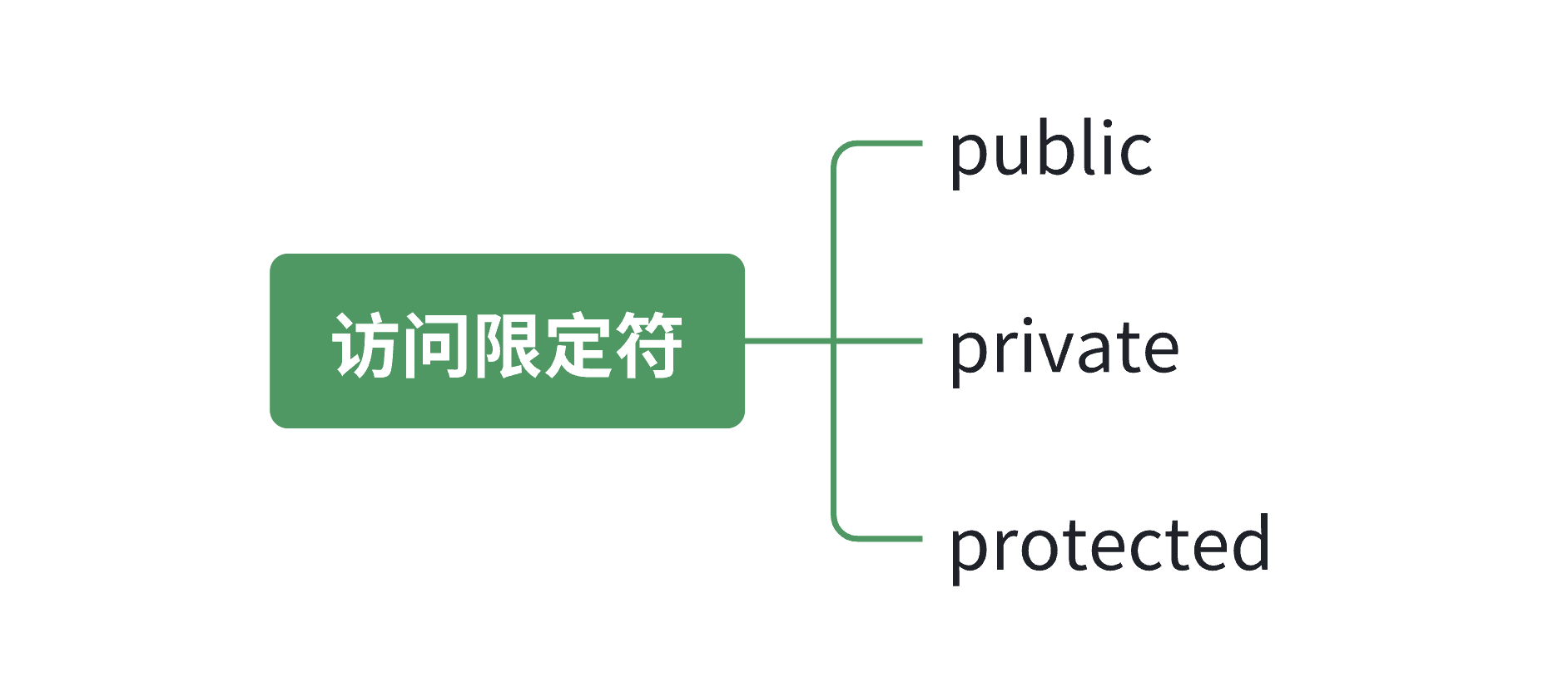
C++通过⼀种实现封装的⽅式,⽤类将对象的属性与⽅法结合在⼀块,让对象更加完善,通过访问权限选择性的将其接⼝提供给外部的⽤⼾使⽤。
public修饰的成员在类外可以直接被访问。protected和private修饰的成员在类外不能直接被访问。
访问权限作⽤域从该访问限定符出现的位置开始直到下⼀个访问限定符出现时为⽌,如果后⾯没有访问限定符,作⽤域就到 }(类结束)。
class定义的成员未被访问限定符修饰时默认为private,struct默认为public。
⼀般成员变量都会被限制为private/protected,需要给别⼈使⽤的成员函数会放为public。
3、类域
类定义了⼀个新的作⽤域,类的所有成员都在类的作⽤域中,在类体外定义成员时,需要使⽤
::域操作符指明成员属于哪个类域。类域影响的是编译的查找规则,下⾯程序中Init如果不指定类域Stack,那么编译器就把Init当成全局函数,那么编译时,找不到array等成员的声明/定义在哪⾥,就会报错。指定类域Stack,就是知道Init是成员函数,当前域找不到的array等成员,就会到类域中去查找。
#include<iostream>
using namespace std;
class Stack
{
public:
void Init(int n = 4);
private:
int* _a;
int _top;
int _capacity;
};
void Stack::Init(int n)
{
_a = (int*)malloc(sizeof(int) * n);
if (_a == nullptr)
{
perror("malloc fail");
return;
}
_capacity = n;
_top = 0;
}
int main()
{
Stack st;
st.Init();
return 0;
}
二、实例化
1、实例化概念
⽤类类型在物理内存中创建对象的过程,称为类实例化出对象。
类是对对象进⾏⼀种抽象描述,是⼀个模型⼀样的东西,限定了类有哪些成员变量,这些成员变量只是声明,没有分配空间,⽤类实例化出对象时,才会分配空间。
⼀个类可以实例化出多个对象,实例化出的对象占⽤实际的物理空间,存储类成员变量。打个⽐⽅:类实例化出对象就像现实中使⽤建筑设计图建造出房⼦,类就像是设计图,设计图规划了有多少个房间,房间⼤⼩功能等,但是并没有实体的建筑存在,也不能住⼈,⽤设计图修建出房⼦,房⼦才能住⼈。同样类就像设计图⼀样,不能存储数据,实例化出的对象分配物理内存存储数据。
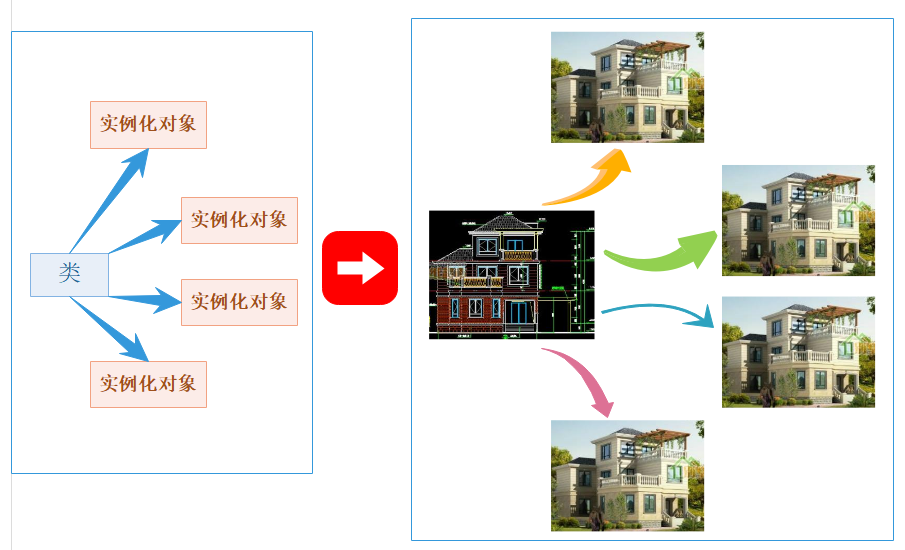
#include<iostream>
using namespace std;
class Date
{
public:
void Init(int year, int month, int day)
{
_year = year;
_month = month;
_day = day;
}
void Print()
{
cout << _year << "/" << _month << "/" << _day << endl;
}
private:
//这里只是声明,并没有开空间
int _year;
int _month;
int _day;
};
int main()
{
//Date类实例化出对象d1和d2
Date d1;
Date d2;
d1.Init(2025,5,1);
d1.Print();
d2.Init(2025, 7, 29);
d2.Print();
return 0;
}
2、对象⼤⼩
类实例化出的每个对象,都有独⽴的数据空间,所以对象中肯定包含成员变量,那么是否包含成员函数呢?⾸先函数被编译后是⼀段指令,对象中没办法存储,这些指令存储在⼀个单独的区域(代码段),因此只能存储成员函数的指针。再分析⼀下,对象中是否有存储指针的必要呢,Date实例化d1和d2两个对象,d1和d2都有各⾃独⽴的成员变量_year/_month/_day存储各⾃的数据,但是d1和d2的成员函数Init/Print指针却是⼀样的,存储在对象中就浪费了。如果⽤Date实例化100个对象,那么成员函数指针就重复存储100次,太浪费了。
还要注意,其实函数指针是不需要存储的,函数指针是⼀个地址,调⽤函数被编译成汇编指令[call 地址],其实编译器在编译链接时,就要找到函数的地址,不是在运⾏时找,只有动态多态是在运⾏时找,就需要存储函数地址。
上⾯我们分析了对象中只存储成员变量,C++规定类实例化的对象也要符合内存对⻬的规则。
内存对⻬规则:
①:第⼀个成员位于结构体偏移量为0的地址处。
②:其他成员变量要对⻬到对⻬数整数倍的地址处。
注意:对⻬数=编译器默认的⼀个对⻬数与该成员⼤⼩的较⼩值,VS中默认的对⻬数为8。
③:嵌套的结构体对齐到自己成员中最大对齐数的整数倍。
④ :结构体总⼤⼩为:最⼤对⻬数(含嵌套结构体的对齐数)的整数倍。
#include<iostream>
using namespace std;
// 计算⼀下A/B/C实例化的对象是多大?
class A
{
public:
void Print()
{
cout << _ch << endl;
}
private:
char _ch;
int _i;
};
class B
{
public:
void Print()
{
//...
}
};
class C
{
};
int main()
{
A a;
B b;
C c;
cout << sizeof(a) << endl;
cout << sizeof(b) << endl;
cout << sizeof(c) << endl;
return 0;
}
实例化对象a的大小计算:
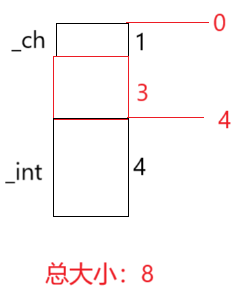
运行结果:

上⾯的程序运⾏后,我们看到没有成员变量的B和C类对象的⼤⼩是1,为什么没有成员变量还要给1个字节呢?因为如果⼀个字节都不给,怎么表⽰对象存在过呢!所以这⾥给1字节,纯粹是为了占位标识对象存在。
三、this指针
Date类中有 Init 与 Print 两个成员函数,函数体中没有关于不同对象的区分,那当d1调⽤Init和Print函数时,该函数是如何知道应该访问的是d1对象还是d2对象呢?那么这⾥就要看到C++给了⼀个隐含的this指针解决这⾥的问题。
编译器编译后,类的成员函数默认都会在形参第⼀个位置,增加⼀个当前类类型的指针,叫做this指针。⽐如Date类的Init的真实原型为:
void Init(Date* const this, int year, int month, int day)类的成员函数中访问成员变量,本质都是通过this指针访问的,如Init函数中给_year赋值,
this->_year = year。C++规定不能在实参和形参的位置显⽰的写this指针(编译时编译器会处理),但是可以在函数体内显⽰使⽤this指针。
#include<iostream>
using namespace std;
class Date
{
public:
//void Init(Date* const this, int year, int month, int day)
void Init(int year, int month, int day)
{
this->_year = year;
this->_month = month;
this->_day = day;
}
//void Print(Date* const this)
void Print()
{
cout << _year << "/" << _month << "/" << _day << endl;
}
private:
int _year;
int _month;
int _day;
};
int main()
{
Date d1;
Date d2;
//d1.Init(&d1,2025,5,1)
d1.Init(2025, 5, 1);
//d1.Print(&d1)
d1.Print();
//d2.Init(&d2,2025,10,1)
d2.Init(2025, 10, 1);
//d2.Print(&d2)
d2.Print();
return 0;
}
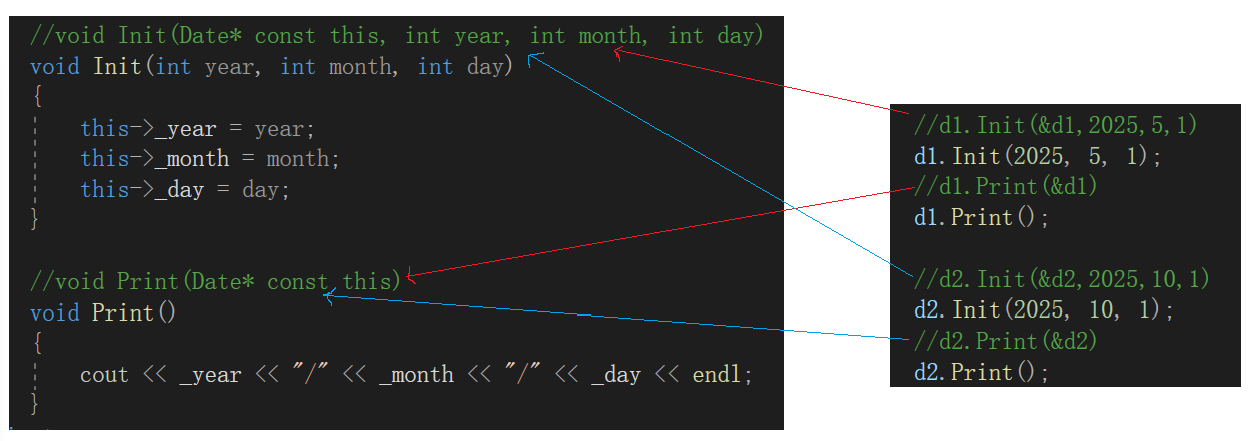
四、C++和C语⾔实现Stack对⽐
⾯向对象三⼤特性:封装、继承、多态,下⾯的对⽐我们可以初步了解⼀下封装。
通过下⾯两份代码对⽐,我们发现C++实现Stack形态上还是发⽣了挺多的变化,底层和逻辑上没啥变化。
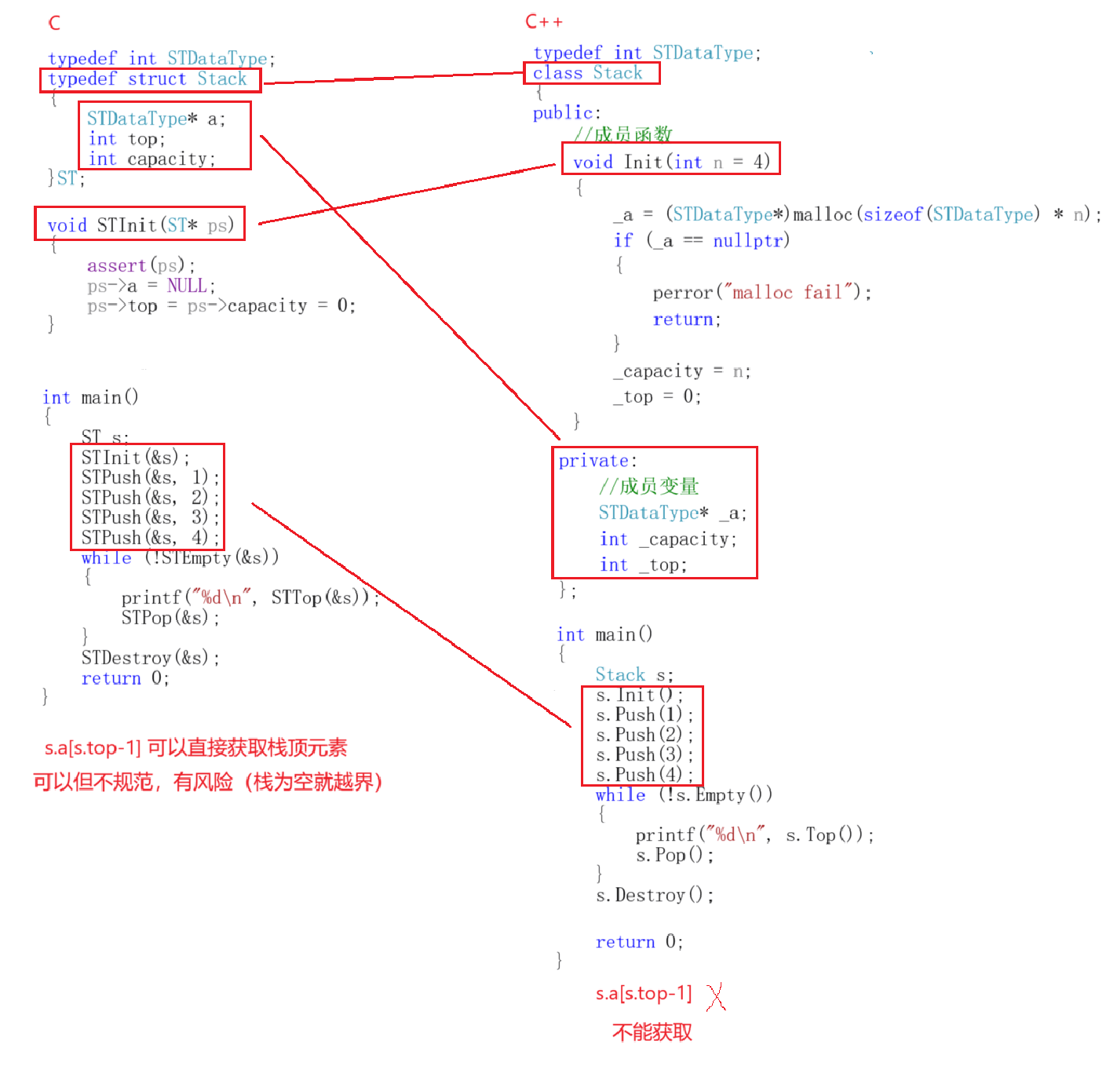
C++中数据和函数都放到了类⾥⾯,通过访问限定符进⾏了限制,不能再随意通过对象直接修改数据,这是C++封装的⼀种体现,这个是最重要的变化。这⾥封装的本质是⼀种更严格规范的管理,避免出现乱访问修改的问题。
C++中有⼀些相对⽅便的语法,⽐如Init给的缺省参数会⽅便很多,成员函数每次不需要传对象地址,因为this指针隐含的传递了,使⽤类型不再需要typedef来命名类名就很⽅便。
C实现Stack:
#include<stdio.h>
#include<stdlib.h>
#include<stdbool.h>
#include<assert.h>
typedef int STDataType;
typedef struct Stack
{
STDataType* a;
int top;
int capacity;
}ST;
void STInit(ST* ps)
{
assert(ps);
ps->a = NULL;
ps->top = ps->capacity = 0;
}
void STDestroy(ST* ps)
{
assert(ps);
free(ps->a);
ps->a = NULL;
ps->top = ps->capacity = 0;
}
void STPush(ST* ps, STDataType x)
{
assert(ps);
//检查空间大小
if (ps->top == ps->capacity)
{
int newcapacity = ps->capacity == 0 ? 4 : ps->capacity * 2;
STDataType* tmp = (STDataType*)realloc(ps->a, newcapacity * sizeof(STDataType));
if (tmp == NULL)
{
perror("realloc fail");
return;
}
ps->a = tmp;
ps->capacity = newcapacity;
}
//入栈
ps->a[ps->top] = x;
ps->top++;
}
bool STEmpty(ST* ps)
{
assert(ps);
return ps->top == 0;
}
void STPop(ST* ps)
{
assert(ps);
assert(!STEmpty(ps));
ps->top--;
}
STDataType STTop(ST* ps)
{
assert(ps);
assert(!STEmpty(ps));
return ps->a[ps->top - 1];
}
int STSize(ST* ps)
{
assert(ps);
return ps->top;
}
int main()
{
ST s;
STInit(&s);
STPush(&s, 1);
STPush(&s, 2);
STPush(&s, 3);
STPush(&s, 4);
while (!STEmpty(&s))
{
printf("%d\n", STTop(&s));
STPop(&s);
}
STDestroy(&s);
return 0;
}
C++实现Stack:
#include<iostream>
#include<assert.h>
#include<stdbool.h>
using namespace std;
typedef int STDataType;
class Stack
{
public:
//成员函数
void Init(int n = 4)
{
_a = (STDataType*)malloc(sizeof(STDataType) * n);
if (_a == nullptr)
{
perror("malloc fail");
return;
}
_capacity = n;
_top = 0;
}
void Push(STDataType x)
{
//检查空间大小
if (_top == _capacity)
{
int newcapacity = _capacity * 2;
STDataType* tmp = (STDataType*)realloc(_a, sizeof(STDataType) * newcapacity);
if (tmp == NULL)
{
perror("realloc fail");
return;
}
_a = tmp;
_capacity = newcapacity;
}
//入栈
_a[_top++] = x;
}
void Pop()
{
assert(_top > 0);
--_top;
}
bool Empty()
{
return _top == 0;
}
int& Top()
{
assert(_top > 0);
return _a[_top - 1];
}
void Destroy()
{
free(_a);
_a = nullptr;
_top = _capacity = 0;
}
private:
//成员变量
STDataType* _a;
int _capacity;
int _top;
};
int main()
{
Stack s;
s.Init();
s.Push(1);
s.Push(2);
s.Push(3);
s.Push(4);
while (!s.Empty())
{
printf("%d\n", s.Top());
s.Pop();
}
s.Destroy();
return 0;
}